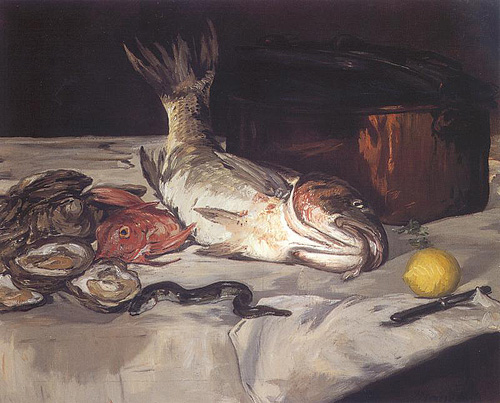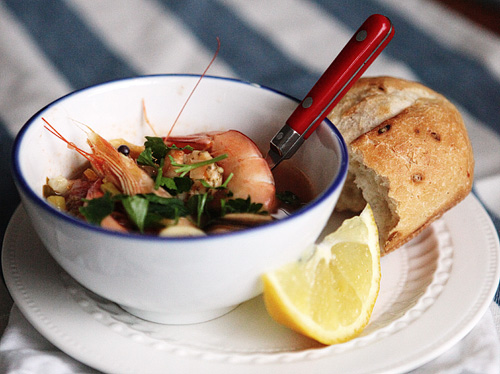The reduction of the genre of still life to its title produces a problem between languages. In English, the name ‘still life’ carries certain connotations. The word ‘life’ produces the idea of movement; the subject is living and has been captured or stilled within the painting. The title creates the idea that ‘still life’ is a captured moment, perhaps a ‘snapshot’ of one’s Sunday dinner. This name is entirely misleading, the still life genre often depicts fish, animals, plants, and commodities – all of which are dead. The name still life is ironic, because life that has been stilled is death. As a French artist, Édouard Manet would have used the French title nature morte, which literally translates to dead nature. The genre was previously known as vie coye, which roughly translates to ‘silent life.’ (1) The distinction between still life and dead nature is important. Manet was certainly aware of the English title ‘still life,’ and this becomes apparent in the strange dichotomy in the painting between life and death. The central image of the fish with its tail suspended in time embodies the living/dead aspect. The fish looks like it is dead with its mouth gaping and eye bulging, yet the broad sweeping brushstrokes and tail flipped into the air, mentioned earlier, suggests movement and thus life. This embodiment of the tension within the title of the genre is an aspect of painting unique to Manet.

Throughout the long history of still life painting, both French and Dutch artists repeatedly used the motif of the fish. Often an idyllic fish is depicted, its silvery scales meticulously painted as it harmoniously blends with the other objects placed within the frame of the canvas. The still life titled Fish (1864) by Édouard Manet is oppositional to this pre-defined way of representation. The large fish becomes the dominating focal point with its mouth gaping open and eye bulging. While gazing at the painting, viewers unintentionally wrinkle their nose; Manet was able to capture with paint the essence of the smell of rotting fish.

Bouillabaisse
adapted from Donna Hay
10 green onions, sliced
1/2 large fennel bulb, thinly sliced
1 clove garlic, minced
1 red chili, sliced
1 TB olive oil
2 TB oil infused with chili
10 saffron threads
1 TB boiling water
1 can crushed tomatoes
6 cups fish stock
1/2 tsp smoky paprika
2 tsp soy sauce
1/2 tsp salt
100 g fresh prawns with the shell
300 g assorted seafood (mussels, calamari, clams, fish)
lemon
parsley
In a large pot, heat the oil over medium-high heat and cook the green onion, garlic, fennel and chili for about 6 minutes, until soft. Meanwhile, place the saffron threads in a bowl of 1TB boiling water and let stand for 5 minutes.
After 6 minutes, add the tomatoes, fish stock and saffron with the soaking water. Bring to a boil and add the paprika, soy sauce and salt. Simmer for 10 minutes.
Add fish and seafood to soup and cook for about 2 minutes, until fish and prawns turn opaque. Remove from heat and top with chopped parsley and a fresh squeeze of lemon. Serve with crusty bread to sop up the broth.

15 comments
OohLookBel says:
Jul 19, 2010
I absolutely love the photo of the bouillabaisse in the bowl with the blue and white accents. Very delicious.
Joanne says:
Jul 19, 2010
That bouillabaisse looks so inviting. I can definitely see the life in the photo as well, with all of bright colors!
Patricia Turo says:
Jul 19, 2010
I love the idea of combining food and art. Lovely site!
Rosa says:
Jul 19, 2010
A beautiful bouillabaisse! Your shot is gorgeous.
Cheers,
Rosa
deana says:
Jul 19, 2010
Beautiful painting and your description is masterful. The thing I like most about the spirit of bouillabaisse is that it is like a jazz riff… what you have around or what you can get makes it what it is… an ever changing delight to be sure. I love your recipe and the photo is, as always, gorgeous!!!
shaz says:
Jul 19, 2010
Thanks for the informative intro, and the painting did make me wrinkle my nose a little :) Gorgeous bouillabaisse.
Tweets that mention Édouard Manet – Bouillabaisse »Feasting on Art -- Topsy.com says:
Jul 20, 2010
[…] This post was mentioned on Twitter by ArtInstituteChicago and Tres Jolie Studios, Chris. Chris said: RT @artinstitutechi: RT @tresjoliestudio: Recipe for Bouillabaisse inspired by @artinstitutechi Manet's Fish (Still Life) http://bit.ly/aYgfx2 #food #art […]
Heavenly Housewife says:
Jul 20, 2010
I love the oil painting. I hear that bouillabaisse is a very hard dish to make in an authentic manner, but yours looks simply wonderful.
*kisses* HH
Julie says:
Jul 21, 2010
Megan, is this the still life that you researched at university? If it is, then this painting started your love affair with still lifes!
Forager @ The Gourmet Forager says:
Jul 21, 2010
Love your informative art posts! Do people really wrinkle their noses at that ‘rotting’ fish in the painting? I looked at its eyes and it looks pretty nice and clear to me – a sure sign its fresh & tasty. But then that just shows how far from being a learn-ed art student I am.
Flintstone says:
Jul 22, 2010
I really like your photo. Seems like I can just reach out and touch it.
my spatula says:
Jul 22, 2010
love this one so much! just perfect!
liz says:
Jul 22, 2010
Ok, only you could write a post on death and rotting fish and then make a beautiful seafood stew! Great writeup of the art – made me appreciate how arresting the painting is. I really want to see it in person now.
Sophie says:
Jul 24, 2010
A great post!! Yeah!!
I love a good home made bouillabaisse! That picture looks truly appetizing!
Katie@Cozydelicious says:
Jul 24, 2010
Amazing how the dead fish do have so much life to them… I love the things you see and point out. Of course, the painting doesn’t make me want bouillabaisse – your photo does that!